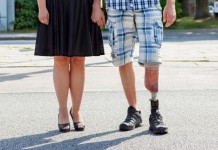Do You Hear What I Hear

Auditory nerves are one eighth of the pair of cranial nerves which are consisting of sensory fibers that conduct impulses from the organs of hearing and from the semicircular canals to the brain.
If a child is born deaf he or she could benefit from cochlear implants if they have the correct auditory nerves. Electrodes that send impulses to the auditory nerve, where they are relayed to the brain and recognized as sound.
The ABI attempts to fill the gap between the nerves that should be in the brain by delivering electrical stimulation directly to the neurons on the brainstem that the nerves would have normally been targeted.
Here is how it works:
The person wears a microphone on their ear to detect sound and a processor changes it to electrical signals. Those are beamed to a stimulator under the skin. This sends the signals snaking through a wire to electrodes surgically placed on the brain-stem.
In 2000 the Food and Drug Administration approved the device but it was specifically for adults and teenagers whose hearing nerves had been destroyed by surgery for a rare type of tumor. No, it doesn’t restore normal hearing but can help to varying degrees.

About a decade ago an Italian surgeon started trying the ABI (Ankle-brachial Index) in deaf children whose younger brains are more flexible and might better adapt to the artificial way of delivering and receiving sound. Hearing specialists are watching the work closely now that the first U.S. studies on young children are underway at a handful of hospitals.
[one_fourth]
[/one_fourth][three_fourth_last](ABI) also known as Ankle-brachial Index is an objective measurement of arterial insufficiency based on the ratio of ankle systolic pressure to brachial systolic pressure.
Dr. Gordon Hughes of the National Institutes of Health is funding Eisenberg’s study. Cochlear implants proved that there is a critical time window when the brain is very receptive to auditory stimulation and can develop speech communication in ways that are surprisingly good, but only if the stimulation is started early enough.
The study is small and will start implants on varying ages. Starting at age 2 children then receive intensive therapy to learn to hear. The studies must prove safety since the ABI requires delicate brain surgery in healthy children.
We are talking about real surgery where doctors will be going into a deep area of the brain. This is a precise operation that requires exact technique. In skilled hands complications appear to be rare, said Robert Shannon, a USC professor of Otolaryngology who has helped develop the device. After the surgery, stimulator complications can include non-auditory sensations such as tingling in the face or throat.
What these researchers and doctors are giving these kids is something very different from what any normal system would provide; to be able to untangle that scrambled pattern inside the brain. The brain itself is picking up the slack and covering the tracks of the doctors.






